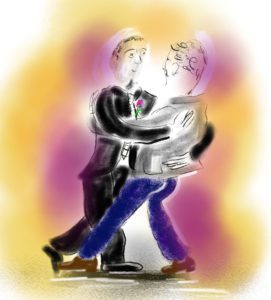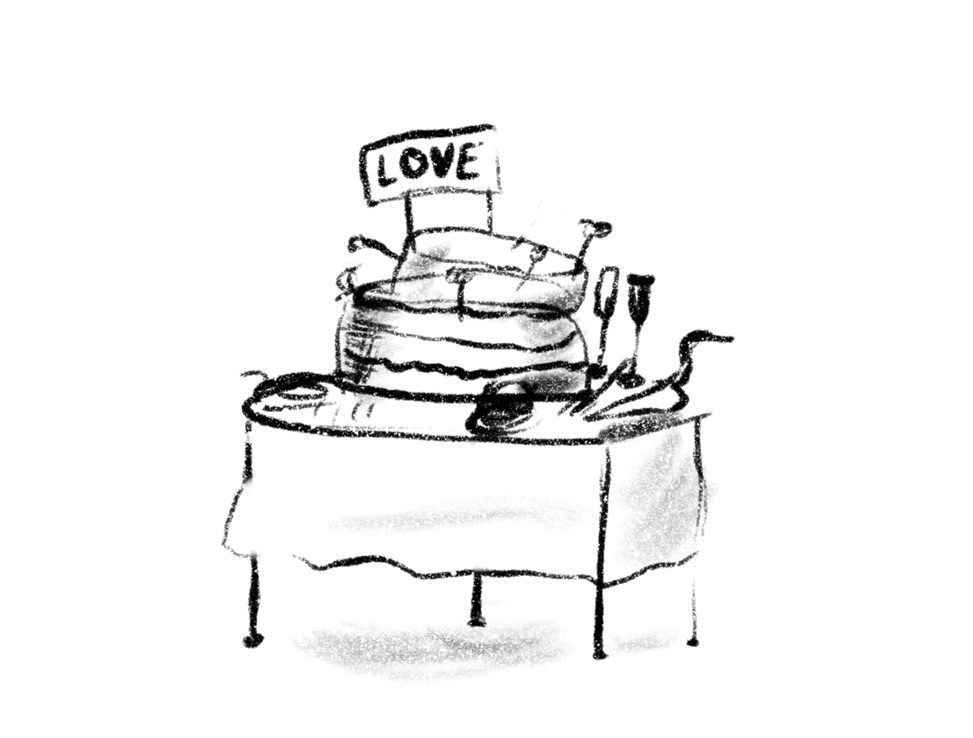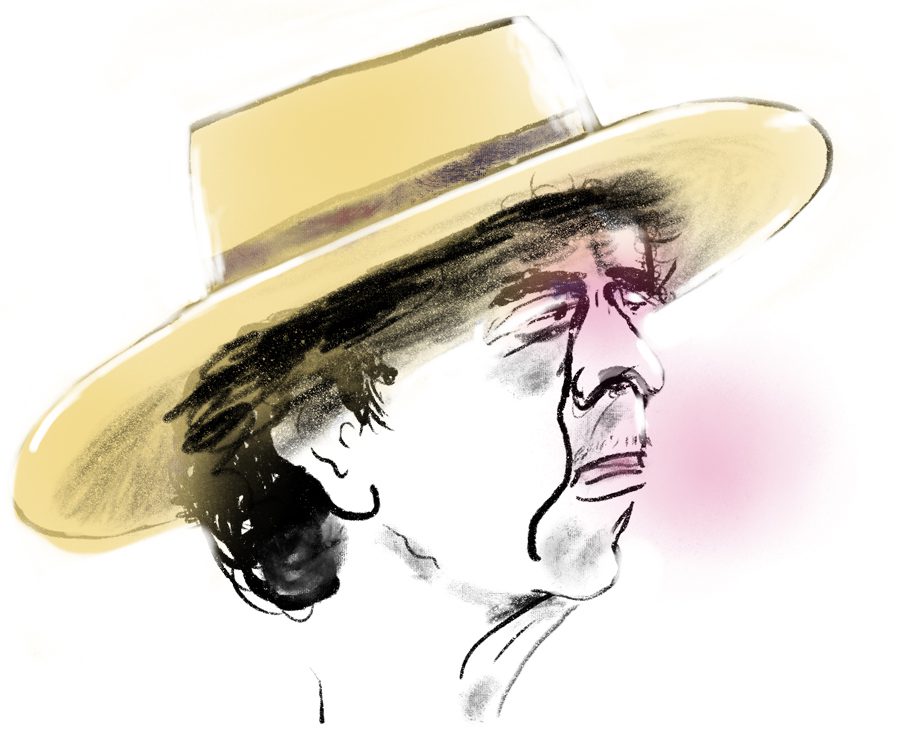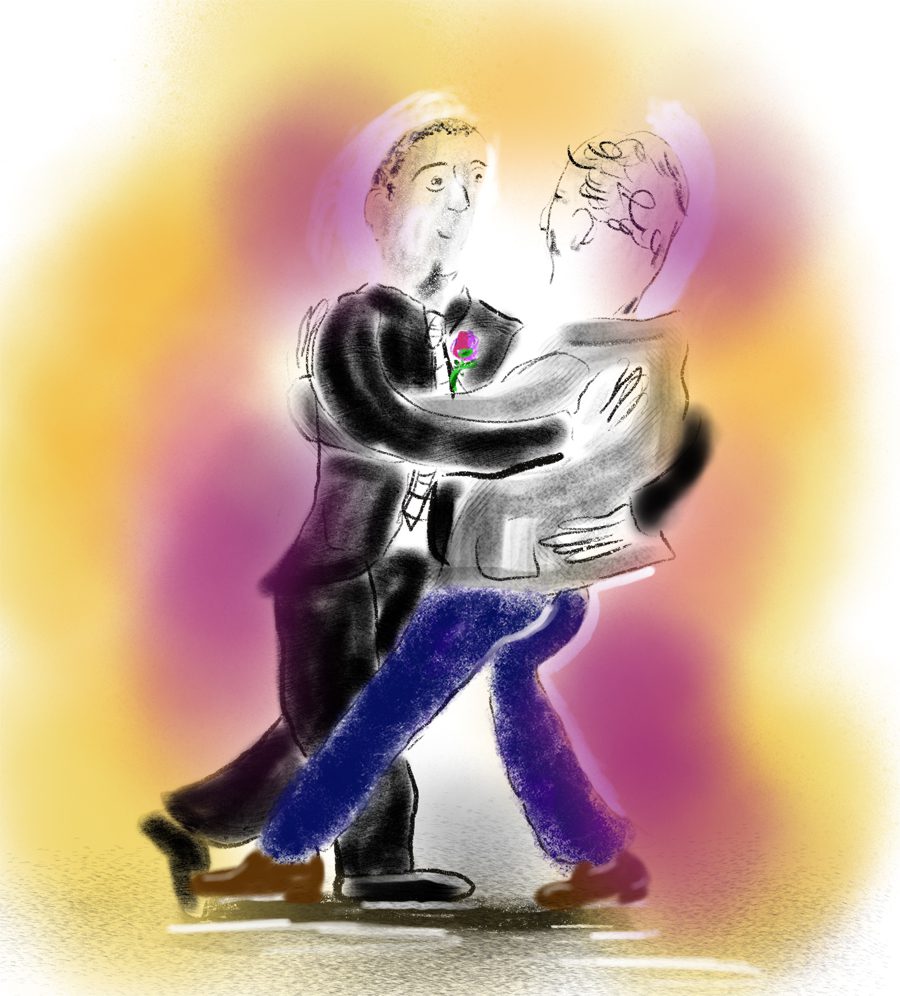
The first verse settles in slowly. Bob Dylan’s scratchy croon leads a piano and strings while Peter and I sway in each other’s arms. Our backdrop, a wall of beer barrels, rises above a wood-slatted bar. Glittery balloons hover over a platter of cake pops. Koozies in a stack bear Peter’s design, a round emblem that reads Paul & Peter, Boston, 2018. On a table behind us rests the last of the wedding cake, a homemade near-disaster we salvaged by plopping a store-bought cake atop our own lopsided attempt, drizzling the two with chocolate, and festooning the confection with fruit-stabbed toothpicks and a wooden sign that reads “Love.”
We’re dressed in the same clothes we wore to the ceremony at Boston City Hall ten days earlier, Peter dashing in his fitted black slacks and suit, a flower in his lapel. I’m in dark jeans and the gray coat I bought when I flew home to Orlando for a friend’s funeral, the coat Mom urged me to take back to Boston, just in case.
Mom hasn’t met Peter—in fact, she’s only recently learned to ask about him on the phone. After performing the straight guy into my early thirties, I’ve just started coming out to family and friends. Peter and I fell in love after more than a year of dating, and now that we’ve decided to do this, to get married, we’re moving fast. With only three weeks’ notice, Mom declined to fly up from Orlando. It’s December, and she plays piano during the holidays for churches and old folks’ homes, so she has prior commitments. And, she doesn’t do well in the cold, even though she’s from New Hampshire. As for my dad, he died of a heart attack nearly a decade ago, so he gets a pass.
In place of my parents, two sets of aunts and uncles drive down from Vermont to join the forty or fifty guests gathered in this side room of a warehouse brewery just north of Boston. They leave after the taco buffet, though, as it was getting late and roads are icy tonight.
Peter’s family isn’t here at all, except for his sister and cousin Skyping in from Trinidad, waving and blowing noise makers through Peter’s laptop. Peter distanced himself from his Pentecostal parents a few years earlier, in his late twenties, when he fled his homeland. For both of us, then, this reception serves as a coming out party, the kind many queers crave when they finally embrace who they are. It represents how much we’ve invested in our relationship, and in ourselves.
A week before our reception, three days married, I beckon Peter to come listen to the song I’ve chosen for our first dance. He peels away from our spreadsheet of guests, supplies, and expenses to meet me in the bedroom of our Brighton apartment. We face each other in sweatpants and sweaters, and I command Alexa to play Bob Dylan’s “He’s Funny That Way.”
The song had come out earlier that year, on the 2018 album Universal Love: Wedding Songs Reimagined. At that time, I was deep into a thesis on Dylan’s creative process. I wasn’t fully out yet, so I privately celebrated Dylan’s queer advocacy, not considering I might use the track in my own wedding.
The original version, “She’s Funny That Way,” first charted in 1929, sung in different releases by Gene Austin and Ted Lewis. Since then, oodles of famous performers have recorded the self-deprecating tune, such as Frank Sinatra, Nat King Cole, and Tony Bennett, all of whom embodied a straight male marveling at his woman’s love. Women performers have adapted the number, too: Billie Holiday, Liza Minelli, and Etta James all sang “He’s Funny That Way.” Dylan may be the first to flip the pronouns in a way that deliberately queers the speaker, though, a move that aligns with his career-long habit of rummaging through the past and reimagining its contents.
Peter takes my hand as the music swells and Dylan’s breathy voice fills the room. On the rug beside the bed, he leads us through a few moves. A dip. A spin. Some booty shakes. With the reception just seven days away, and still so much to prepare, it’s no wonder Peter doesn’t propose an alternative. He knows how important it is to me, a Dylan scholar—a Dylanologist—to have Bob Dylan in our wedding, even if he’d have chosen Lady Gaga, or Brandi Carlile—something with a woman’s voice wailing out emotion. Adele’s cover of Dylan’s “To Make You Feel My Love” would’ve suited us both, and folks would’ve recognized the melody. But Dylan seems to have served up this number just for us.
I’m not out to everyone when we send the invitations. Sending them takes longer because each time I text the invite is another coming out to someone I wish I would’ve come out to sooner. I can only do so many in a day before the anxiety overwhelms me. But now, the guests have all arrived: Peter’s workmates and some friends I still need to meet, a gaggle of my grad-school buddies, a handful of my hometown friends who, to my happy surprise, have flown up despite the short notice. Everyone’s drinking and chattering over the live music, a local singer-songwriter we found to kick off the event.
When the time comes for our grooms’ speeches, I switch on the microphone and flip on the speaker. Right then, the main hall next door begins pumping out its Friday night electronic dance music. By way of each row relaying to the folks behind them the speeches are about to start, we gather the room’s attention.
“Peter and I went on our first date last summer in Harvard Square,” I begin. The attendees lean in to hear, their curiosity plain to see. I set the narrative of a relationship many are just learning about, and I get some laughs as I confess to adopting some of Peter’s phrasings. Instead of looking for a parking spot, now I “find a park.” I don’t turn the lights off anymore, I take them off. “You poor t’ing” I say when Peter isn’t feeling well. It’s fun to blend these Englishes, like we’ve blended the rest of our lives.
“Everyone give it up for my wonderful partner and husband,” Peter says, taking the mic. “Without a doubt I know the three of us will be very happy: Paul, myself, and Bob Dylan. Did I mention Bob Dylan? I’m pretty sure Paul has brought him up to at least sixty-five percent of this audience in the last hour.”
For our one-year anniversary, Peter gifts me the “He’s Funny That Way” music sheet, framed and attributed to Bob Dylan. I feel grateful again he never questioned my choice of songs. Not that he doesn’t question Dylan in general—the frequent hostility toward women in his lyrics, the use of the N-word in “Hurricane,” the appropriation of Jamaican culture in “I and I.” Most of all, Peter questions the arrogance of Dylan rarely, if ever, addressing the crowd from the stage. But he appreciates Dylan’s genius, too, and his influence over contemporary music. And, about a year into our marriage, when I take Peter to see Dylan in concert, he humors me and my jabbering over the songs—the tweaked lyrics, the altered arrangements—even if he doesn’t stand for the encore.
“He’s Funny That Way” is by no means Dylan’s first nod to queer identity. Perhaps the most famous instance appears in 1974’s “You’re Gonna Make Me Lonesome When You Go,” when the speaker relates himself to Verlaine and Rimbaud, the quarrelsome same-sex couple of the French symbolist movement. Yet the song also supplies references to Dylan’s mistress at the time. During their countryside strolls, she later reported, she pointed out Queen Anne’s Lace flowers and told Dylan about her birthplace, Ashtabula, Ohio. Both details snuck into the song. While biographical readings tend to be problematic, in this case it underscores how the song, though it lacks distinguishing pronouns, fits within a broader context of heterosexual love.
Drag culture pops up in Dylan’s catalogue as well. Crossdressing appears in “Temporary Like Achilles” and “Obviously Five Believers,” both from 1966’s Blonde on Blonde. Given Dylan’s fascination with carnival and burlesque culture, the periodic gender-bending is hardly surprising. In 2000’s “Things Have Changed,” Dylan offhandedly sings that he’s going to “dress in drag.” A few lines later, though, he’s back to the heteromasculine notion of “fallin’ in love with the first woman I meet.” The drag, meanwhile, is just a passing idea—another quick wardrobe change. Dylan appears to be straight-slumming it for an eyebrow raise and a laugh.
At the wedding, minor-third strings waft from our bluetooth speaker. Peter and I come together. I fumble over his arms and shoulders, but his grip is firm. The music projects romance. Awws spring up around the room. My right hand clutches Peter’s left, my left hand finds his waist. And Bob Dylan’s gruff, sibilant voice recalls, “Once he dressed in silks and lace…”
Nervous, self-conscious, I pluck a piece of lint off Peter’s shoulder. He laughs, his smile reassuring, his waist pressed into mine. His neck smells of the bee’s wax bar soap we’ve been sharing since moving in together. Dylan’s smoky warble envelops us. “I’ll just have to stop and think / Why he fell for me.” Peter kisses my hand, evoking another aww from the crowd. A slow spin and we flash our arms, showman-like. “I got a man crazy for me,” Dylan moans as we stammer through another spin. The crowd whoops and applauds.
To be sure, Dylan’s history of masculine bluster, along with his explicit comments, overshadow any incidental queerings of his catalogue. His most notorious statement on queer relationships came during his gospel era in the late 1970s and early ‘80s, when he evangelized from the stage. “When we started out this tour, we started out in San Francisco,” Dylan said to an audience in Hartford, Connecticut, in 1980. “It’s a kind of unique town these days. I think it’s either one third or two thirds of the population that are homosexuals… I guess they’re working up to a hundred percent.” Dylan bemoaned that the gays had a “political party,” and that their activity wasn’t “going on in somebody’s closet.” The point? “I guess the iniquity’s not yet full. And I don’t want to be around when it is.”1
Kurt Loder probed Dylan about his religious beliefs during a Rolling Stone interview in 1984. By then, Dylan’s sanctimony had, if not disappeared, at least simmered down. When Dylan referred in passing to Allen Ginsberg’s Buddhism, Loder pressed: “Speaking of Allen Ginsberg, doesn’t the Bible say that homosexuality is an abomination?”
“Yeah, it does. It does say that,” Dylan said, then added, “But that’s no reason for me to condemn somebody, because they drink or they’re corrupt in orthodox ways or they wear their shirt inside out. I mean, that’s their scene. It certainly doesn’t matter to me. I’ve got no ax to grind with any of that.” He was already shifting, forging a path to leave condemnation behind. Now he was an MTV music video star, soon to become a Traveling Wilbury, a folk singer (yet again, but with more grizzle), a wily wanderer on the Never-Ending Tour.
Dylan wasn’t on tour in June 2014, when his youngest known daughter, Desiree, who’s less than two years younger than I am, married her wife, Kayla. All the same, he didn’t attend the wedding, and the family apparently didn’t expect him to. “Of course he’s invited, but he’s just not going to go,” Kayla’s mom told New York Daily News at the time. “He didn’t say that, but that’s what we are assuming.”
Born in the ‘80s, Desiree was a secret to the world until Howard Sounes uncovered her existence, along with Dylan’s marriage to singer Carolyn Dennis, in a 2001 biography. The couple, who divorced in 1992, hoped to give Desiree a normal childhood, and that’s what happens to normal kids—they often get married, to the same sex, to the opposite sex, to any and every sex. For Dylan to skip the wedding “would be sad,” Kayla’s mom said, though she added, “He is really supportive and happy for her.”
How supportive was he, I wonder, if he wasn’t there in person?
As the chorus drifts away again, Peter and I draw close. A musical interlude with traipsing flutes and we try a little shimmy. A bridge and Peter spins me halfway, hugs me from behind and—this one we rehearsed—sneaks his left hand up to my breast where, facing the crowd, I slap it away. It’s affection. It’s performance. Peter breaks, bending over in laughter. “I love it!” someone shouts. Dylan extends the syllables: “He’s. Funny. That. Wayyy.”
Peter and I kiss again and take our bows and I’m so glad it’s over. Had my mom been here, she and I would’ve had our own dance. It would’ve been the first time I’d seen her in person since I came out to her a few months earlier, on the night before her brother’s funeral in Columbus, Ohio. We were having drinks and sharing stories in a booth at Chili’s. She was “shocked,” she said, relaying, “I feel like I’m in a dream.” Then I told her I was dating a guy named Peter while she nodded, mouth ajar. A dance would’ve brought her into the arms of her queer son, who was transforming from a person she thought she understood into one she must accept.
Peter and I rest for a couple days before flying to Orlando for a pre-honeymoon in a timeshare his parents keep but don’t use; he’s told them he’s going alone, to take a break from work. In Orlando, we head to my mom’s duplex for a “nice luncheon,” with a couple more aunts, another uncle, and a cousin. Mom toasts to us in part with lyrics from “Forever Young,” and she stifles a sob at the line about the “ladder to the stars.” I choke up, too, because I know in that moment, she acknowledges how much effort it has taken for me to come out, to get married, to claim a fuller version of myself, even if it’s a version she doesn’t fully comprehend.
In time, as Peter and I move into our own apartment and buy a sectional couch, a desktop computer, a new used car; as we take an Easter honeymoon in New Orleans; as we pool our resources to buy a house—Mom will start to get it. Her voice will begin to brighten when mentioning Peter. She’ll even visit us in Massachusetts, learning to love Peter as she buys into the notion that it is indeed possible to queer the American Dream.
I still wonder why Dylan would skip his daughter’s big day. Did he fear going out into public? Did he not want to take the spotlight off the couple? Or was he supportive, but, like, not that supportive?
Maybe he opted for a nice luncheon.
I can’t speak for Desiree, but I imagine we share some of the same feelings: compelled to understand that not everyone can make your wedding; compelled to be chill, despite the disappointment. There are reasons parents can’t attend—it was too cold, and too quick, for my mom. A heart attack meant my dad didn’t have to choose. He too was an evangelical Christian, but he would’ve come around, like Dylan. I know he would’ve, just like I know Mom would’ve liked to have been there. For the sake of our relationship, I might as well believe it. But that doesn’t mean, when we scroll through our reception photos and watch the video of our first dance, Peter and I aren’t disappointed our parents weren’t there.
A year later, when Peter’s mom finds out, she recommends gay conversion. To this day she texts him information to that effect. Peter isn’t sure what his dad knows, or what he cares to know. So, even if invited to our wedding, Peter’s parents probably wouldn’t have come, unless to try and halt the proceedings, make a scene, demand their child return home and seek God’s forgiveness.
I wonder how much forgiveness was on Dylan’s mind when he recorded “He’s Funny That Way,” and how much his mind was on Desiree and Kayla. Even though there isn’t a female pronoun in the song, I like to think he sang it for them, to atone for his absence, and that he sang it for us. By recording this song, Dylan made himself present at an untold number of same-sex weddings. His blessing is palpable, even if we’ll never know what he really believes.
***
Rumpus original art by Liam Golden.
***
1. See Patrick Webster’s book, A Wanderer by Trade: Gender in the Songs of Bob Dylan (McFarland, 2019) for a full transcription and discussion of Dylan’s speech from his concert at the Bushnell Memorial Hall, Hartford, Connecticut, on May 8, 1980.↩







